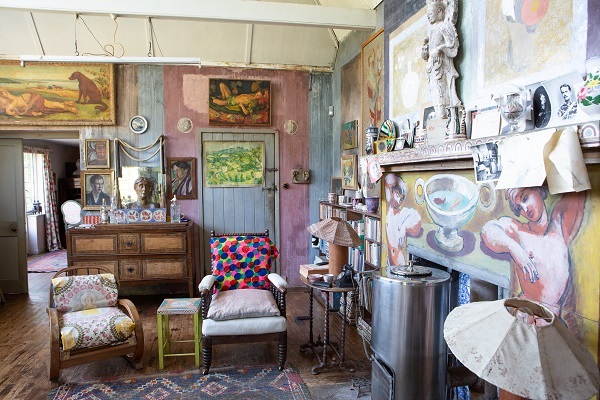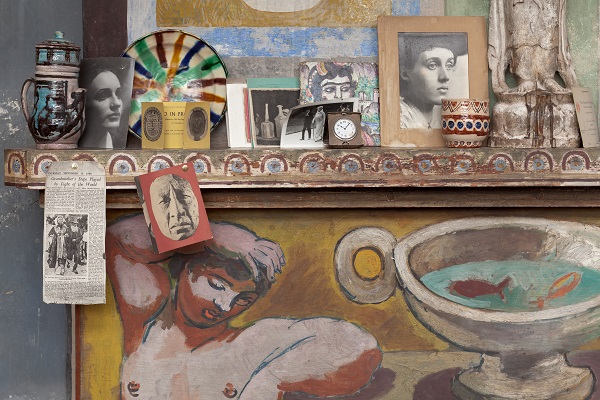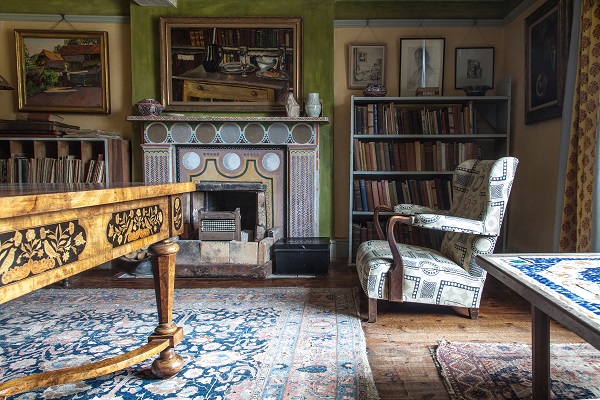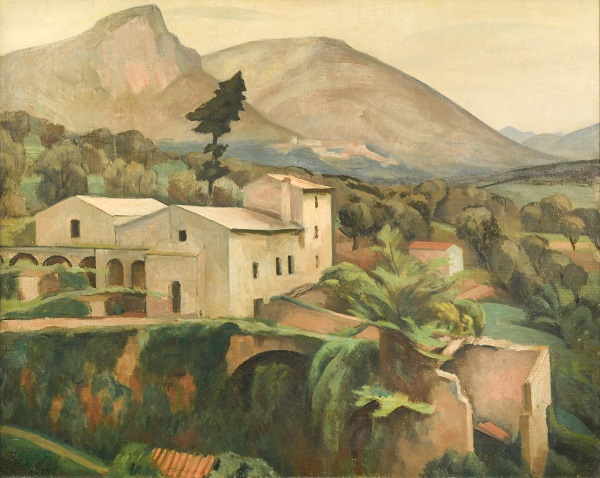Said to have ‘lived in squares, painted in circles and loved in triangles’*, the Bloomsbury Group was a legendary band of individuals, who were famed as much for their artistic and literary efforts as they were for their bohemian lifestyles. Redefining the landscape of British Modernism, the group had a major impact on the art, design and literary movements of the early 20th century and throughout the first World War, and as contemporary tastes have shifted, their decorative style is now right back in the centre of fashion.

The studio at Charleston, courtesy of The Charleston Trust, photography by Lee Robbins
It all started in 1905 when a select few writers and intellectuals would meet at the London home of artist Vanessa Bell and her sister Virginia Woolf. Slowly, this group grew, introducing artists, authors, critics, curators and designers including the likes of Duncan Grant, Clive Bell, E.M Forster, Lytton Strachey and Roger Fry. Over the coming years, the group would become famous for their modernist and decorative artwork, cutting edge writing and the designs for fabric and homeware which were produced by the Omega Workshops, set up by Roger Fry in 1913. The culmination of some of the key members decorative labours can be seen at Charleston Farmhouse, the famous Sussex home of Vanessa Bell and Duncan Grant, which sees every wall and surface covered in paintings and patterns. Charleston became a somewhat mythical place, inhabited by this contingent of fascinating individuals, who, when you pulled the curtain back, had created the epicentre of all that was modernist at the time.

Duncan Grant’s studio at Charleston, courtesy of The Charleston Trust, photography by Penelope Fewster
Time hasn’t blurred the interest in the Bloomsbury Group today, in fact, they appear now be more fashionable than ever. On the 14th September, London-based dealer, Philip Mould, opened an exhibition titled ‘Charleston – The Bloomsbury Muse’ and delves deeper into the lifestyle at Charleston and the important work which was carried out there during WW1. Similarly, at Charleston itself, an exhibition solely of Duncan Grant’s work is taking place, 101 years after his first solo show.
And whilst the artwork of the Bloomsbury Group has always been hugely sought-after, demand for pictures by the likes of Roger Fry, Vanessa Bell and Duncan Grant has really taken off in the past couple of years. Last year, a portrait by Roger Fry of E.M Forster set a new world record for the artist at Bonhams, when it made £325,000 and similarly at Christie’s in March this year, a picture titled ‘Autumn Bouquet’ by Vanessa Bell sold for £256,250. We would expect that following these two major exhibitions, works by these artists could see a further jump in values as buyers gain confidence in their presence in the public eye.

Clive Bell’s study at Charleston, courtesy of the Charleston Trust, photography by Penelope Fewster
When it comes to interior decoration, the current trends for pattern and design are helping to bring the group back to the fore of modern-day tastes. Patterns from the Omega workshop are highly coveted, and inspiration is being taken from the murals and wall paintings at Charleston itself. In addition, furniture painted in patterns as seen in the likes of The Tolstoy Edit, are becoming increasingly popular. In fact, #paintedfurniture has seen over 1.4 million posts on Instagram to date, proving the popularity of this whimsical way of decorating. And we need to remember that the majority of the decoration at Charleston was created during wartime, a period of make-do and mend, staying at home and making the best of what you had. Not unlike the past 18 months where we have all spent far more time in our homes than ever before. People are clearly taking inspiration from what could be called ‘The Charleston Effect’ and are looking to decorate furniture, paint lampshades and create that vibrant and multi-layered look which the Bloomsbury Group was all about.

Mountains in Vence, by Roger Fry, available at the Cheffins Art & Design Sale on 28th October, estimate £6,000 - £8,000
Perhaps the ultimate in this trend would be to adorn your walls in original artwork by the group. And at Cheffins in October, we will be selling an oil painting by Roger Fry and two drawings by Duncan Grant, consigned from the late Angelica Garnett, the daughter of Vanessa Bell and Duncan Grant. The Fry picture, titled ‘Mountains in Venice’ is dated 1926 and is typical of his signature style, it has an estimate of £6,000 - £8,000. Whilst the drawings by Duncan Grant are two nude studies, which have an estimate of £600 - £800.
The catalogue for the Art & Design sale at Cheffins will go live on our website next month.
*According to writer Dorothy Parker - https://www.tate.org.uk/art/art-terms/b/bloomsbury